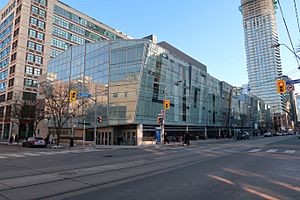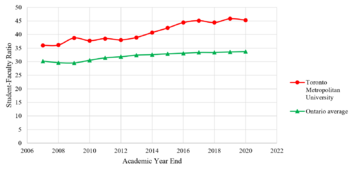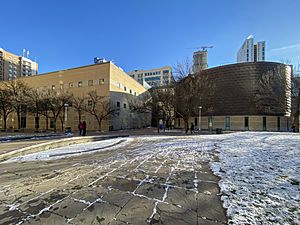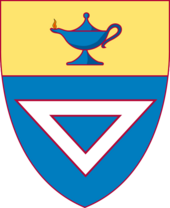Toronto Metropolitan University facts for kids

|
|||||||
|
Former names
|
|
||||||
|---|---|---|---|---|---|---|---|
| Motto | Mente et artificio (Latin) | ||||||
|
Motto in English
|
With mind and skill | ||||||
| Type | Public | ||||||
| Established | September 16, 1948 | ||||||
|
Academic affiliation
|
AACSB, COU, IAU, Universities Canada | ||||||
| Endowment | C$136.285 million | ||||||
| Chancellor | Donette Chin-Loy Chang | ||||||
| President | Mohamed Lachemi | ||||||
| Provost | Roberta Iannacito-Provenzano | ||||||
| Undergraduates | 44,400 | ||||||
| Postgraduates | 2,950 | ||||||
| Location |
,
Ontario
,
Canada
43°39′27.85″N 79°22′48.64″W / 43.6577361°N 79.3801778°W |
||||||
| Campus | Urban; 121 acres (49 ha) | ||||||
| Student newspapers | The Eyeopener On The Record |
||||||
| Colours | Blue and gold
|
||||||
| Nickname | TMU Bold | ||||||
|
Sporting affiliations
|
U Sports, OUA | ||||||
| Mascot | Falcon | ||||||
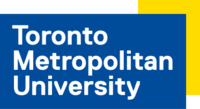 |
|||||||
Toronto Metropolitan University (TMU, also called Toronto Met) is a large public university in Toronto, Canada. It is a place for learning and research. The main campus is in downtown Toronto, in an area called the Garden District. The university also has other buildings around the city.
TMU has seven main academic areas, called faculties. These include the Faculty of Arts, the Faculty of Community Services, and the Faculty of Science. There are also schools for engineering, architecture, law, and business. Many of these are divided into smaller departments. The university also offers classes for adults who want to keep learning.
The university started in 1948 as the Ryerson Institute of Technology. It was named after Egerton Ryerson, who helped create the public school system in Canada West. Over the years, the school grew and changed its name several times. In 1993, it became a full university. In 2022, its name changed to Toronto Metropolitan University. This change happened because of concerns about Egerton Ryerson's connection to the Canadian Indian residential school system.
TMU is open to both male and female students. In the 2019–20 school year, about 44,400 undergraduate students and 2,950 graduate students attended. As of 2024, over 240,000 people have graduated from TMU. The university's sports teams are called TMU Bold. They compete in university sports leagues like U Sports.
Contents
History of Toronto Metropolitan University
How the University Started
After the Second World War, leaders in Toronto saw a need for special schools. These schools would help returning soldiers learn skills for new jobs. One person, Howard Hillen Kerr, visited a famous school in the United States. He imagined a similar place in Canada that would connect high school learning with university studies.
This idea led to the creation of vocational schools and technical institutes in Ontario. In 1948, the Ryerson Institute of Technology officially opened. It was named after Egerton Ryerson, who had helped set up a teacher training school on the same site many years before.
Early Growth and Changes
When it first opened, the Ryerson Institute of Technology had about 250 students. Howard Hillen Kerr was the first principal. The school first offered two-year programs to train students for specific jobs. Later, it added three-year programs. In 1952, English, physical education, and history became required subjects for all students.
The number of students grew quickly. So, in 1958, construction began on the first building made just for the institute. This building, called Kerr Hall, was finished in 1963. Other buildings were later added around a central courtyard.
Becoming a University
In 1964, the school was renamed Ryerson Polytechnical Institute. It was given its own board to manage its affairs. In the 1970s, the institute gained the power to grant some university degrees.
By 1993, the institute became a full polytechnic university. It was renamed Ryerson Polytechnic University. This meant it could also focus on scholarly research. In 1997, a school for graduate studies was created. In 2002, the name was shortened to Ryerson University.
Name Change to Toronto Metropolitan University
In 2015, a report about the Canadian Indian residential school system was released. This report led to discussions about Egerton Ryerson's role in creating that system. Many people felt the university's name should change because of this history.
In 2018, a plaque was placed next to a statue of him on campus. It explained his connection to the residential school system. In 2021, the statue was removed. In August 2021, the university decided to change its name. On April 26, 2022, the new name, Toronto Metropolitan University, was announced. The name change became official in December 2022.
Exploring the Campus
Where the University Is Located
Toronto Metropolitan University's main campus is in downtown Toronto. It blends in with the city, so you might not see clear signs marking where the campus begins. Most of the campus is for university use, but some parts are also used for businesses and homes. The height of buildings on campus is limited to protect flight paths for air ambulances going to nearby hospitals.
The main part of the campus is bordered by Gerrard Street to the north, Jarvis Street to the east, Dundas Street East to the south, and Yonge Street to the west. Kerr Hall is like the "heart" of the campus. Gould Street, south of Kerr Hall, is a main path that connects different parts of the campus.
Campus Spaces and Buildings
Many streets and paths on campus are open to the public. Some streets, like Victoria Street south of Gerrard Street, are only for people walking. Gould Street was also closed to cars in 2012. This pedestrian-only part of Gould Street is called Toronto Metropolitan University Square. In winter, it even has an outdoor skating rink!
Most of the parks and green spaces on campus are owned by the university but are open to everyone. These include Devonian Square and the quadrangle at Kerr Hall. Devonian Square has a reflecting pool and large rocks that are billions of years old from the Canadian Shield. There's also a green roof and urban farm on top of the George Vari Engineering and Computing Centre. This farm grows many different crops.
The university has over 40 buildings. Some are very old, like Oakham House from 1848. Others are new, like the Daphne Cockwell Health Sciences Complex, which opened in 2019. Many early buildings were built in a style called Brutalist architecture. The campus has grown a lot since 2000, almost doubling in size.
University Buildings and Facilities
The university uses many buildings, some of which are shared with other businesses. Besides owning properties, the university also leases or shares ownership of other buildings near the main campus.
- 10 Dundas East (DSQ)
- 101 Gerrard Street East (COP)
- 111 Bond Street (BON)
- 111 Gerrard Street East (GER)
- 112–114 Bond Street (BND, PRO)
- 415 Yonge Street (YNG)
- Architecture Building (ARC)
- Atrium on Bay (AOG)
- Bell Trinity Square (BTS)
- Campus Store (BKS)
- Civil Engineering Building (Monetary Times) (MON)
- Centre for Urban Innovation (CUI)
- The Chang School of Continuing Education (Heaslip House) (CED)
- Daphne Cockwell Health Sciences Complex (DCC)
- George Vari Engineering and Computing Centre (ENG)
- International Living/Learning Centre (ILC)
- Jorgenson Hall (JOR)
- Kerr Hall (KHN, KNE, KNS, KNW)
- Library Building (LIB)
- Mattamy Athletic Centre (MAC)
- Merchandise Building (MER)
- Oakham House (OAK)
- O'Keefe House (OKF)
- Pitman Hall (PIT)
- Podium (POD)
- Real Institute (College Park) (CPK)
- Rogers Communications Centre (RCC)
- The Image Centre
- Sally Horsfall Eaton Centre (SHE)
- School of Graphic Communications Management (Heidelberg Centre) (HEI)
- School of Interior Design (SID)
- Sheldon & Tracy Levy Student Learning Centre (SLC)
- South Bond Building (SBB)
- St. Michael's Hospital (SMH)
- Student Campus Centre (SCC)
- Ted Rogers School of Management (TRS)
- Yonge–Dundas Intersection (YDI)
- Victoria Building (VIC)
Library and Museum
The Toronto Metropolitan University Library is the main library. It is in an 11-story building finished in 1974. In 2012, the library had over 522,000 books and many online resources. Next to the library is the Sheldon & Tracy Levy Student Learning Centre, completed in 2015. This building has lots of study spaces, but no books.
The Image Centre is a museum and home to the School of Image Arts. It has several galleries, including one for student art. The center also stores the university's large collection of photographs. It has about 375,000 items, including historical photos and collections from famous magazines.
Student Housing and Services
The university has three student residences on campus, with about 1,144 beds. These are the Daphne Cockwell Complex, the International Living & Learning Centre, and Pitman Hall. Most students do not live on campus, but about 18% of first-year students do. The university also has themed floors in residences, like a "fashion floor" for fashion students.
The university offers dining services, but because it's in downtown Toronto, there are many other food places nearby. The Student Campus Centre is a hub for student activities and groups. It has offices for student organizations, lounges, study areas, and restaurants.
Off-Campus Facilities
The Toronto Metropolitan University Aerospace Engineering Centre is a research center located at Downsview Park. It opened in 2018 and is a partnership with companies like Bombardier. This center helps faculty and graduate students do research with industry partners. The university's soccer team also uses sports facilities at Downsview Park.
In 2022, the university announced plans to open a medical school in Brampton. The city of Brampton gave the university land and a building for this purpose.
Sustainability Efforts
The university has an office that works on making the campus more environmentally friendly. TMU has signed agreements to show its commitment to sustainability. In 2009, it joined other Ontario universities in a pledge to become models of environmental responsibility.
How the University is Run
Toronto Metropolitan University is managed by two main groups: a board of governors and a senate. The board of governors handles the university's money and property. It has 24 members, including the chancellor, president, and elected representatives from students, staff, and alumni.
The senate is in charge of the university's education policies. It has 52 elected members from the university community, plus the chancellor, president, and other leaders.
The chancellor is the head of the university in name. They mainly give out degrees. The current chancellor, Donette Chin-Loy Chang, was appointed in October 2024. The president is the chief executive officer. They manage the university's daily operations. Mohamed Lachemi has been the president since September 2016.
University Funding
Toronto Metropolitan University is a public university, meaning it gets money from the government. In the 2019–2020 school year, the university had about $833 million in income. Most of this came from government grants and student fees. More than half of the university's expenses go towards salaries. As of April 2020, the university's special fund, called an endowment, was worth over $136 million.
What Students Learn
| Faculty | # of students |
|---|---|
| Faculty of Arts | 5,373 |
| The Creative School | 6,028 |
| Faculty of Community Services | 6,746 |
| Faculty of Engineering and Architectural Science | 5,949 |
| Faculty of Science | 4,243 |
| Ted Rogers School of Management | 11,814 |
The university has three terms: fall, winter, and spring/summer. Academic programs are run by seven faculties. These include Arts, Community Services, Engineering and Architectural Science, Science, The Creative School, and the Lincoln Alexander School of Law. The Ted Rogers School of Management is the university's business school. The Lincoln Alexander School of Law is the newest faculty, starting in September 2020.
Most faculties are divided into smaller departments or schools. For example, the Faculty of Arts has ten departments for humanities and social sciences. The Creative School has nine schools for media, design, and creative industries.
Graduate programs are managed by the Yeates School of Graduate Studies. TMU also works with Sheridan College and York University on some programs. The G. Raymond Chang School of Continuing Education offers over 400 courses for adults.
In the 2019–20 school year, the university had 909 full-time teachers. There were 28,800 full-time undergraduate students and 2,600 full-time graduate students. In 2017, TMU had the highest number of students per teacher in Ontario. In 2023, there were 33 students for every teacher.
In 2018, the university awarded over 7,000 bachelor's degrees and over 1,000 master's degrees. Most bachelor's degrees were in business. Most master's and doctoral degrees were in engineering or social sciences. About 74% of students who started in 2011 graduated.
TMU is a member of many national and international university groups. Its business school is also recognized by a group called the Association to Advance Collegiate Schools of Business.
University Rankings
| University rankings | |
|---|---|
| Global rankings | |
| ARWU World | 901–1000 |
| QS World | 801–1000 |
| Times World | 801–1000 |
| Times Employability | 191 |
| U.S News & World Report Global | 1452 |
| Canadian rankings | |
| ARWU National | 25–26 |
| QS National | 27 |
| Times National | 28–30 |
| U.S News & World Report National | 34 |
| Maclean's Comprehensive | 8 |
| Maclean's Reputation | 19 |
In 2023, Maclean's magazine ranked TMU eighth among Canadian comprehensive universities. It was also ranked 19th for its reputation. Globally, TMU has been ranked among the top 801–1000 universities by QS World University Rankings and Times Higher Education World University Rankings in 2023.
The university also ranks well for how easily its graduates find jobs. In 2022, Times Higher Education placed TMU 192nd in the world for graduate employability.
Research at TMU
Toronto Metropolitan University does a lot of research. As of February 2021, it had 37 research centers and institutes. In 2018–19, the university published over 1,300 academic papers. It also partnered with over 300 groups for research funding.
In 2018-19, TMU received $17.1 million from a major Canadian research council. It also raised $49.6 million from governments and $13.2 million from industries for research. In 2020, Research Infosource ranked TMU 23rd among 50 Canadian research universities.
One famous research project from TMU is hitchBOT. This was a hitchhiking robot created by a TMU professor and a professor from another university. It was part of a project to study how humans interact with robots.
Business Incubator Network
The university runs Canada's largest network of university-based business incubators. These are called the Zone Learning network. It has 11 incubators that help new businesses in different areas.
The first and largest incubator is The DMZ. It started in 2010. The DMZ helps new technology companies connect with investors and experts. As of January 2023, the DMZ has helped over 750 businesses and created over 4,800 jobs. In 2018, it was named the world's best university-based business incubator.
In 2020, TMU partnered with the City of Brampton to launch the Brampton Venture Zone. This incubator helps international startups enter the North American market.
Becoming a Student
The requirements for getting into TMU are different for students from Ontario, other parts of Canada, and other countries. This is because grading systems vary. If English is not a student's first language, they must show they are good at English. In 2018–19, the average high school grade for new Ontario students was 85.4%.
In 2019–20, about 81.9% of students continued in the same program after their first year. For all first-time, full-time students, 88% stayed at the university.
Student Life at TMU
| Undergraduate | Graduate | |
|---|---|---|
| Male | 44.42% | 47.57% |
| Female | 55.58% | 52.43% |
| Canadian student | 93.77% | 86.79% |
| International student | 6.23% | 13.21% |

In the 2019–20 school year, TMU had about 44,400 undergraduate students and 2,950 graduate students. Most students (over 93%) are from Canada. Nearly 80% of undergraduate students come from the Greater Toronto Area.
A 2015 survey showed that about 54% of TMU students used public transit to get to campus. About 23% used regional transit, 14% walked, and 5% biked. Dundas subway station is the closest subway stop to the campus.
Student Groups and Organizations
Full-time undergraduate students are represented by the Toronto Metropolitan Students' Union (TMSU). Graduate students have their own union. Part-time students and those in continuing education also have a student association. These student unions are part of the Canadian Federation of Students. They offer services like academic help, legal advice, and medical insurance.
Each faculty has its own student society. These groups help students get involved, develop skills, and support their well-being. They plan events like orientation weeks and formal dances. Some academic programs also have course union clubs. These clubs help students in a specific program feel connected.
The university does not officially recognize fraternities and sororities. However, some operate unofficially. Some of these groups are open to students from different universities in Toronto.
Student Media
The university has several student-run media outlets. These include student newspapers and a campus radio station. CJRU, also known as Met Radio, has been the university's non-profit radio station since 2016.
The Eyeopener is a student newspaper that started in 1967. It is run by a student-owned company and funded by student fees. Students from the School of Journalism also publish Review of Journalism and On the Record. On the Record also produces a newscast called OTR TV.
University Athletics
The university's sports teams are called TMU Bold. They compete in the Ontario University Athletics conference of U Sports for most sports. Varsity teams include badminton, basketball, ice hockey, soccer, and volleyball. The university also has many other sports clubs like baseball, curling, and rugby. The first sports teams were formed in 1948.

TMU has three main athletic facilities: the Recreation and Athletic Centre, Kerr Hall Gymnasium/West, and the Mattamy Athletic Centre. The Recreation and Athletic Centre is the main hub. It has a fitness center, gyms, an indoor track, a pool, and squash courts. The Mattamy Athletic Centre is located in the upper part of Maple Leaf Gardens. It has a cardio room, courts for basketball and volleyball, an ice-hockey rink, and a dance studio. Most varsity games are played at the Mattamy Athletic Centre or Kerr Hall Gymnasium.
The university's athletic mascot used to be a ram. From 1961 to 1991, they even had live ram mascots! A costumed ram mascot was introduced in the 1980s. In 2022, when the teams changed their name to TMU Bold, the mascot was changed to a falcon.
University Symbols
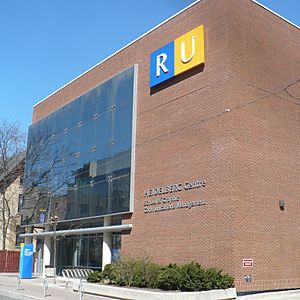
When the university first started, it used a crest and a seal. In 1966, an official coat of arms was granted. The university also uses a logo with its official colors: azure (blue) and gold. Blue stands for loyalty and truth, and gold for generosity and learning.
The university has an official seal to make documents official. A new seal was introduced in 2022. It shows the Student Learning Centre in the middle. A student designed this new seal in a competition.
Motto and Song
The university's Latin motto is Mente et Artificio. This means "With Mind and Skill." This motto was inspired by the motto of MIT, which means "With Mind and Hand." TMU's motto was changed to its current form in 1950.
The university also has a song called The School Song. It was created in the 1950s.
Coat of Arms
The university received its coat of arms in 1966 from the College of Arms in London, England. It was officially registered in Canada in 1999.
The coat of arms includes ram Aries supporters, which represent creative ideas. The torches on the rams symbolize light, education, and knowledge. On the shield, there is a Lamp of Learning for intelligence and a set square for construction. The full coat of arms is mainly used by the chancellor and president. After the name change, the university now uses a simpler version of its coat of arms without the rams.
|
Notable People from TMU
Many people are connected to Toronto Metropolitan University as graduates, staff, or teachers. As of 2017, there were almost 170,000 TMU graduates around the world. All graduates are part of the University Alumni Association. Alumni and faculty have won important academic awards.
Graduates of TMU have become successful in many different areas. In business, notable alumni include Patrick Dovigi (GFL Environmental) and Isadore Sharp (Four Seasons Hotels and Resorts). In the arts, famous alumni include actors like Nina Dobrev and Eric McCormack. Writers like Louise Penny and Robert J. Sawyer also graduated from TMU.
Many notable people have also taught or worked at the university. These include David Crombie, a former Secretary of State for Canada, and Jack Layton, a former leader of the official opposition in Canada. Stuart McLean, a Canadian radio host and author, was a journalism professor. G. Raymond Chang, a business leader, was the university's chancellor from 2006 to 2012.
See also
 In Spanish: Universidad Metropolitana de Toronto para niños
In Spanish: Universidad Metropolitana de Toronto para niños
- Education in Toronto
- Higher education in Ontario
- List of Canadian universities by endowment
- List of colleges and universities named after people
- List of universities in Ontario
- Open College (Toronto)
- Ryerson Radio



